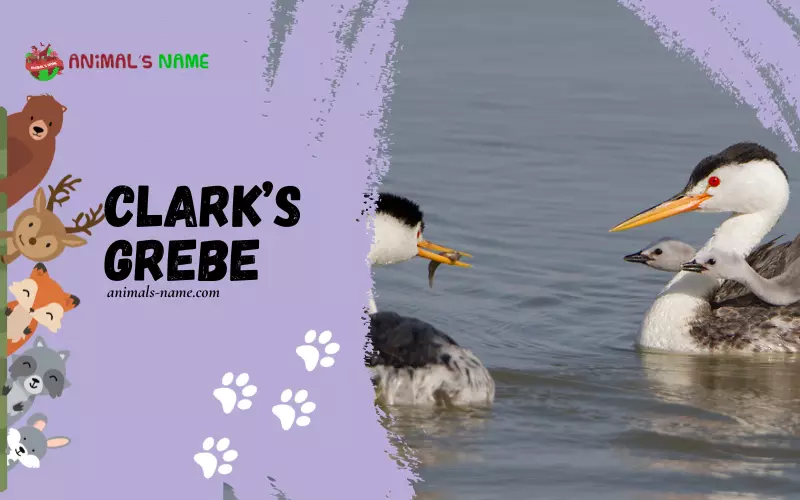Clark’s Grebe is a fascinating bird found in North America. With its unique appearance and exciting behaviours, this species has captured the attention of bird enthusiasts and researchers alike. This blog post will delve into the Clark’s Grebe’s history, facts, size, habitat, and classification.
Historically, the Clark’s Grebe was named after the American explorer William Clark. As one of the largest grebes, it measures around 20 to 30 inches in length. This bird is easily distinguishable by its slender neck, bright red eyes, and striking black and white plumage. Clark’s Grebes are known for their remarkable courtship displays, where they engage in a synchronized dance known as “rushing.” This behaviour involves the birds running on water, creating an impressive sight for observers.
Regarding habitat, Clark’s Grebes prefer freshwater lakes, marshes, and reservoirs. They can be found along the western regions of the United States and Mexico. These birds are exceptional divers and swimmers, with their uniquely shaped feet allowing them to navigate through water effortlessly. Their diet consists mainly of fish, insects, and crustaceans, which they catch while diving underwater.
Classification-wise, the Clarks Grebe is part of the Podicipedidae family, commonly known as grebes. These water birds are known for their ability to swim and dive expertly. There are several grebes species, each with distinctive characteristics and habits. Understanding the classification of this bird provides valuable insight into its evolutionary history and relationship with other avian species.
History of Clark’s Grebe
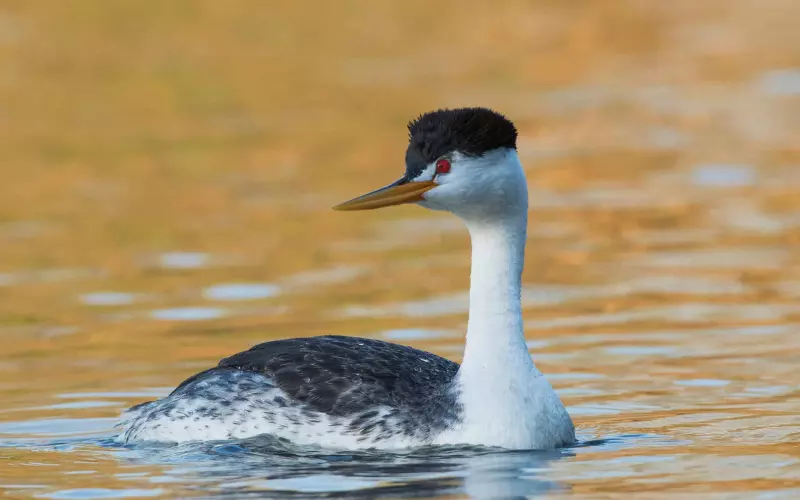
The Clark’s Grebe bird has a fascinating history that spans many years. This bird is native to North America, particularly the western parts of the United States. It is often found in freshwater lakes and reservoirs, where it builds nests and raises offspring.
The history of the Clark’s Grebe bird can be traced back to the early 19th century when the first scientific observations were made. These observations helped scientists better understand the behaviour and characteristics of this unique bird species. Over the years, more research has been conducted, shedding light on its feeding habits, migration patterns, and breeding behaviours.
One interesting fact about the Clark’s Grebe bird is its distinctive mating dance. The male and female birds dance on the water’s surface during courtship. This dance involves mirroring each other’s movements, diving together, and even running on water. This display is not only a beautiful sight to behold but also serves as a bonding ritual between the pair.
Despite its long and rich history, the Clark’s Grebe bird faces some challenges today. Habitat destruction, pollution, and human disturbance have taken a toll on its population. Conservation efforts are now being made to protect and preserve their habitats, ensuring that future generations can continue to witness the beauty and grace of this remarkable bird.
Importance of Clark’s Grebe
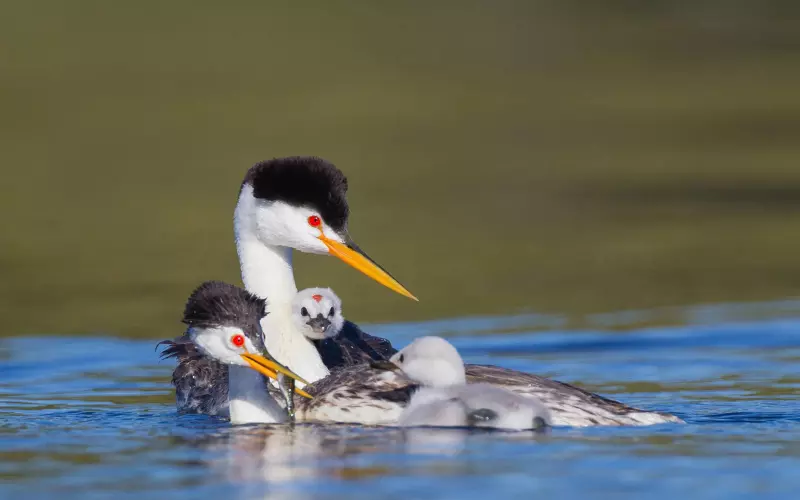
Clark’s Grebe is an essential bird species that plays a crucial role in maintaining the balance of its habitat. These beautiful birds are native to North America and are commonly found in freshwater lakes and reservoirs. This species is known for its unique mating dance, a remarkable display of courtship and helps find a suitable partner for reproduction.
One of the critical roles of Clark’s Grebe in its ecosystem is controlling the population of certain aquatic organisms. They primarily feed on small fish and invertebrates, helping to keep their numbers in check. By doing so, they contribute to the overall health of the aquatic ecosystem they inhabit. Additionally, the presence of these birds can indicate the presence of a healthy and diverse aquatic environment.
Moreover, Clark’s Grebe also serves as an indicator of the general health of their habitat. Pollution, habitat degradation, and human activities can negatively impact their population. Therefore, monitoring and protecting these birds can help us assess the overall well-being of the ecosystem they inhabit.
Clark’s Grebe is a beautiful, fascinating bird and a crucial species for maintaining a balanced ecosystem. By controlling the population of certain aquatic organisms and indicating the health of their habitat, these birds play an essential role in preserving the natural environment. Protecting and supporting the survival of Clark’s Grebe is essential for the overall well-being of the ecosystems they inhabit.
Amazing Facts About Clark’s Grebe
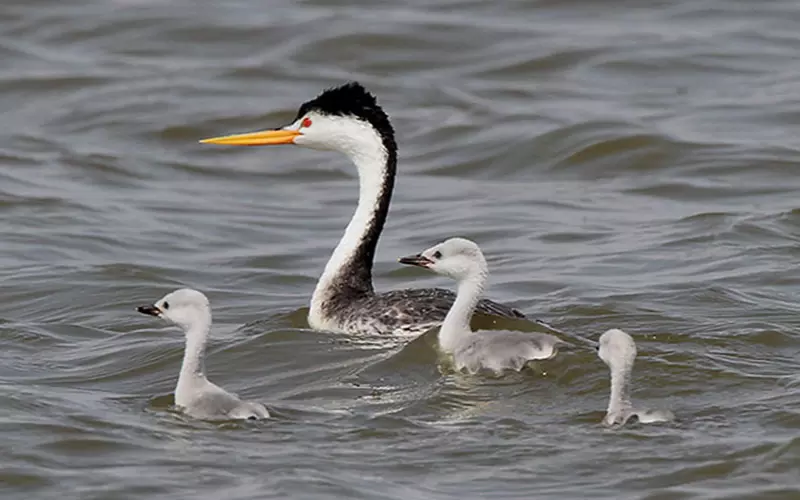
1. The Clark’s Grebe is a bird species commonly found in western North America.
2. It is named after the American ornithologist William Clark, a famous Lewis and Clark Expedition member.
3. The Clark’s Grebe is a medium-sized bird, measuring about 20 to 30 inches long with a wingspan of approximately 24 to 31 inches.
4. These birds have an elegant appearance: a long, slender neck, a pointed black bill, and a white body with dark grey to black feathers on the upper parts.
5. They are excellent swimmers and spend most of their time in freshwater lakes, ponds, and marshes.
6. Clark’s Grebes are known for their unique mating ritual called “rushing,” where they run across the water’s surface as a pair, creating a beautiful synchronized display.
7. They feed on fish and consume insects, crustaceans, and small amphibians.
8. These birds have specialized adaptations for efficient swimming, such as lobed toes and legs positioned far back on their bodies, which helps propel them through water.
9. Clark’s Grebes are expert divers, capable of staying underwater for several minutes to catch their prey.
10. During the breeding season, they build floating nests made of plant materials at the water’s edge, attaching them to emergent vegetation.
11. Females typically lay two to four eggs in a clutch, and both parents take turns incubating the eggs for about 22 to 27 days.
12. The chicks can swim and dive shortly after hatching but still rely on their parents for protection and food.
13. Although Clark’s Grebes are generally silent, they produce a variety of calls during courtship and when communicating with their young ones.
14. These birds are migratory and often travel to breeding sites in the northern regions during the summer months and then move south to warmer areas during the winter.
15. While the population of Clark’s Grebe is currently considered stable, they face threats from habitat loss, pollution, and disturbances caused by human activities. Conservation efforts are essential to ensure the long-term survival of these beautiful birds.
Can we keep Clark’s Grebe as our Pet?

We cannot keep Clark’s Grebe bird as a pet. It is essential to understand that keeping wild animals as pets is not a good idea. These birds are meant to live freely in their natural habitats, and keeping them in captivity can negatively affect their well-being.
Clark’s Grebe is a species of bird that has faced challenges recently. Though not extinct, they are endangered for various reasons, such as habitat loss and pollution. This means their population has decreased significantly, and conserving and protecting them in the wild is crucial. Trying to keep them as pets would only further endanger their existence.
Our responsibility is to respect and protect the natural world and its animals. Instead of keeping wild animals as pets, we should focus on supporting conservation efforts and learning about these creatures in their natural environments. By doing so, we can contribute to their survival and ensure a healthier planet for all living beings, including the fascinating Clark’s Grebe bird.
Size of Clark’s Grebe
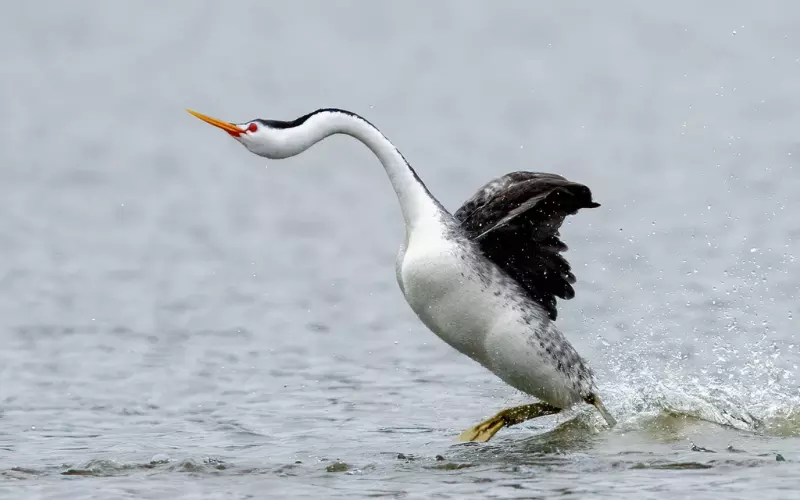
The Clark’s Grebe bird is a fascinating creature that can be found in North America. Its size is impressive, reaching up to 24 to 29 inches long. That’s almost the length of two school rulers! Their wingspan can be even more impressive, measuring around 30 to 36 inches, like the width of a big TV screen.
One exciting feature of the Clark’s Grebe is its long and slender neck. It stands out as it extends from its body and allows the bird to search for food underwater. It has a beautiful black cap on top of its head, and its body is primarily white. This combination of colours makes it a distinct and striking bird to see.
Despite its size, the Clark’s Grebe swims quite agilely and gracefully. It has webbed feet that help it paddle and glide through the water effortlessly. You might even mistake it for a dancer, as it performs an elegant courtship display with its partner, where they mirror each other’s movements in perfect harmony.
The Clark’s Grebe bird is a large and fascinating bird found in North America. Its impressive size, long neck, beautiful black cap, and graceful swimming make it an incredible sight. So, watch for this magnificent bird on your next nature walk by the water!
Habitat of Clark’s Grebe
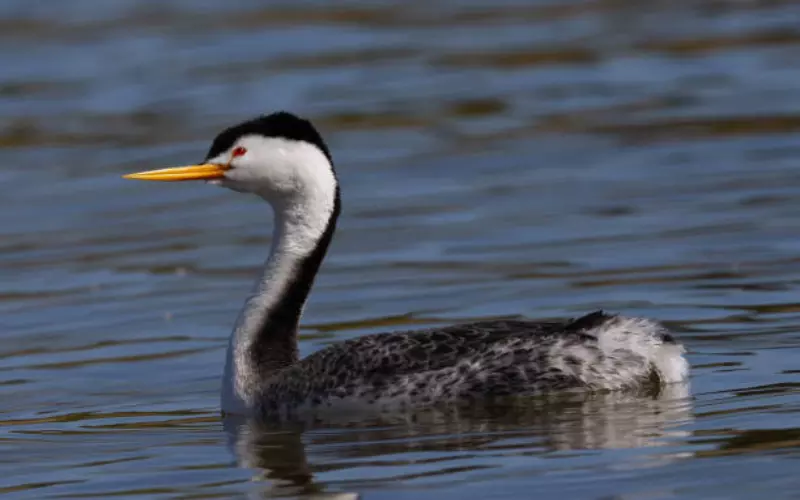
Clark’s grebe is a fascinating bird that can be discovered in various habitats across North America. These graceful creatures primarily reside in freshwater lakes and ponds, where they can find plenty of food and suitable nesting sites. The habitat of Clark’s Grebe includes calm waters with abundant aquatic vegetation and regions with open spaces for courtship displays and raising their young.
To begin with, Clark’s grebes are commonly found in lakes and ponds because they provide the ideal conditions for these birds to thrive. In these freshwater habitats, the birds can easily search for their primary food sources, such as fish and aquatic invertebrates. Additionally, vegetation like reeds and water lilies provides shelter and nesting grounds for these birds. The calm nature of the water in lakes and ponds also ensures that the grebes swim effortlessly and catch their prey efficiently.
Moreover, Clark’s grebes prefer habitats that offer open spaces for courtship displays. During mating season, these birds engage in an elaborate dance ritual called the “rushing ceremony.” The open areas in their habitat allow them to perform these beautiful displays, which involve synchronized movements and are an essential part of their breeding behaviour. Therefore, access to unobstructed water bodies is crucial for Clark’s grebes to carry out their courtship rituals successfully.
Lastly, suitable nesting sites are essential for Clark’s grebes to raise their young. Often, they construct floating nests made of aquatic vegetation in shallow areas close to the shore. These nests protect the grebe chicks from predators and allow them to stay safe until they are old enough to enter the open water. Therefore, appropriate nesting locations are vital for Clark’s grebes’ survival and reproductive success.
Clark’s grebes can be found in various habitats across North America, with a preference for lakes and ponds. These habitats provide calm waters, abundant food sources, suitable nesting sites, and open spaces for courtship displays. Understanding and preserving these habitats can ensure these remarkable birds’ continued existence and their ecosystems’ biodiversity.
Evolution of Clark’s Grebe
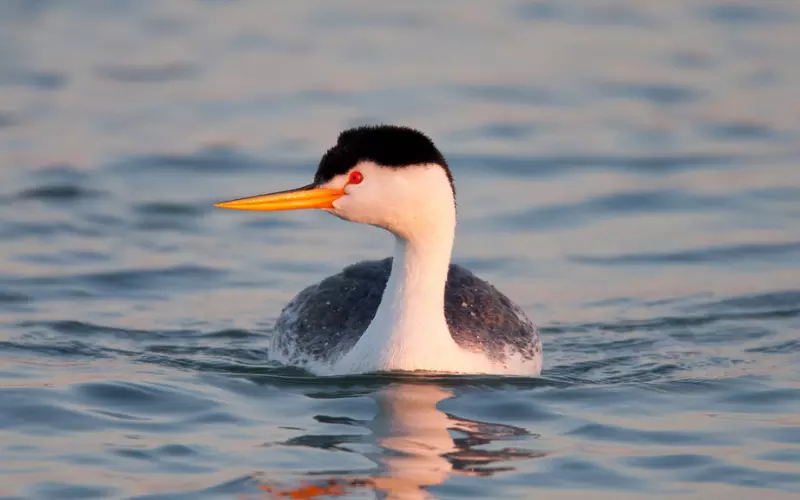
The Clark’s Grebe bird has undergone remarkable changes throughout its evolutionary journey. These changes happened gradually over a long period. The first significant development in the evolution of Clark’s Grebe was the adaptation of its wings for efficient flying. Early ancestors of this bird had wings that were not as strong, which made it difficult for them to cover long distances in search of food and suitable breeding habitats.
Over time, the Clark’s Grebe bird evolved longer and more powerful wings. This adaptation allowed them to fly for more extended periods without getting tired. With improved flying abilities, they could migrate to areas with more resources, such as abundant food sources and safer nesting sites. This evolution allowed them to survive and thrive in various environments.
Another significant evolution of the Clark’s Grebe is related to its swimming abilities. Early ancestors of this bird had legs and feet that were not specialized for swimming. As the bird’s environment changed, with a shift towards living in wetlands and freshwater bodies, their legs and feet became more suitable for swimming. Their legs became more extended, and their feet developed lobed toes that could better propel them through the water. These adaptations made the Clark’s Grebe one of the most skilled swimmers among birds, enabling them to catch fish and other aquatic prey easily.
The Clark’s Grebe bird has evolved to become a proficient flyer and swimmer. Its wings and legs underwent significant changes, allowing it to cover long distances while flying and swim effortlessly in water. These adaptations helped the Clark’s Grebe bird to survive and adapt to various habitats, making it a thriving species in different environments.
Classification of Clark’s Grebe
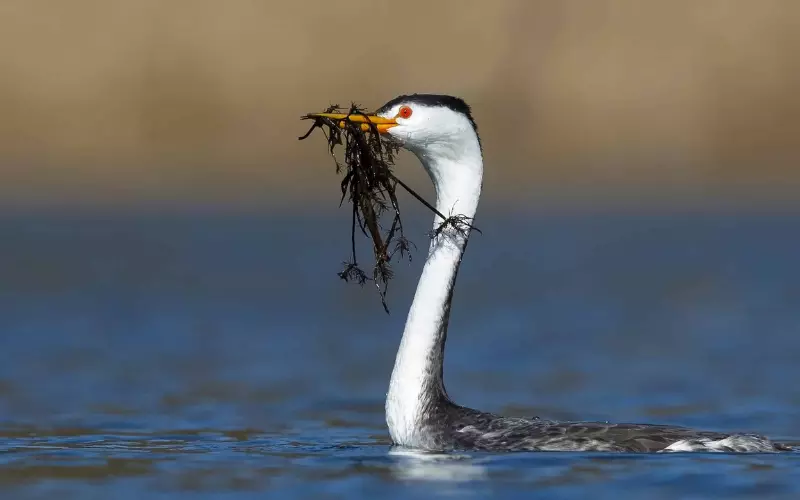
The Clark’s Grebe bird is a beautiful and graceful creature belonging to the Grebes family. It is scientifically called Aechmophorus clarkii. This bird is primarily found in North America, mainly in the western part of the continent, specifically in the United States and Mexico. Its habitat includes freshwater lakes and marshes.
The Clark’s Grebe bird is known for its striking appearance. It has a long, slender neck, which it uses to catch fish and other small aquatic creatures. Its body is primarily white, with black feathers on the back and wings. During the breeding season, its plumage becomes even more vibrant, with a shiny black head and neck and bright red eyes. This bird has webbed feet, which allow it to swim and dive with exceptional agility.
In terms of classification, the Clark’s Grebe bird falls under the Animal Kingdom, as it is an animal. It belongs to the class Aves, which includes all birds. This class is further classified under the order Podicipediformes, which comprises grebes. In the family Podicipedidae, the Clark’s Grebe bird is categorized under the genus Aechmophorus and another species of grebe, the Western Grebe.
The Clark’s Grebe bird is a unique and fascinating creature in various parts of North America. It is a member of the Grebe family with distinctive features and behaviours. Understanding the classification of this bird helps scientists and bird enthusiasts learn more about its characteristics and relationship with other species.
Different Types of Clark’s Grebe
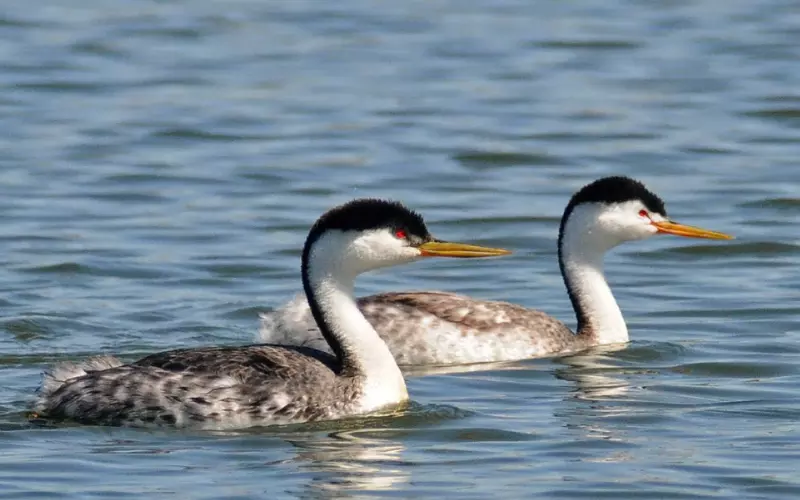
1. Appearance: Clark’s Grebe is a medium-sized water bird with a long, slender neck, a black cap on its head, and a white body. It has red eyes and a long, pointed bill that helps it catch small fish.
2. Breeding: During the breeding season, these grebes display elaborate courtship rituals, including synchronized swimming, head shaking, and mutual preening. They build floating nests made of water plants in shallow water near the shore.
3. Range: Clark’s Grebes are found in western North America, especially in freshwater lakes and ponds throughout California, Nevada, and Oregon. They prefer areas with dense aquatic vegetation for nesting and feeding.
4. Diet: These birds are skilled divers and swimmers, feeding mainly on small fish such as minnows, sunfish, and perch. They also consume crustaceans, insects, and tadpoles, hunting their prey underwater.
5. Threats: Pollution, habitat loss, and disturbance from human activities pose significant threats to Clark’s Grebes. The destruction of wetlands and water pollution affect their habitat and food sources, while boating and recreational activities can disrupt their breeding and feeding behaviours.
6. Migration: In winter, Clark’s Grebes migrate to coastal areas or large lakes to find suitable feeding grounds. They migrate in large flocks and can travel long distances to reach their wintering sites.
7. Vocalizations: These birds make various sounds, including a mournful call that sounds like “woo-oo-oo.” They use these vocalizations to communicate with their mates and during territorial disputes.
8. Plumage change: Like other grebes, Clark’s Grebes undergo a moulting process where they shed their old feathers and grow new ones. During this time, their wings become temporarily non-functional, making them unable to fly until their new feathers are fully grown.
9. Courtship behaviour: Clark’s Grebes engage in a stunning courtship display called “rushing,” where they run across the water’s surface together in tandem. This behaviour strengthens the bond between mates and reinforces their pair bond.
10. Conservation status: Clark’s Grebes are considered a species of most minor concern, according to the International Union for Conservation of Nature (IUCN). However, their populations still face habitat loss, pollution, and disturbance threats, highlighting the importance of conservation efforts to ensure their long-term survival.
Geographical Presence of Clark’s Grebe
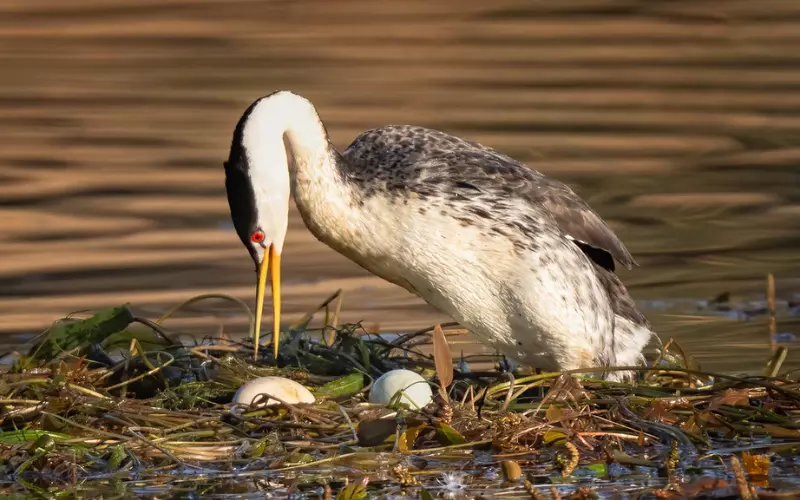
Clark’s Grebe birds are native to the western region of North America. These beautiful birds can be found in California, Oregon, and parts of Nevada and Utah. They prefer habitats with large freshwater lakes, reservoirs, and river systems. Clark’s Grebes are known for their elegant appearance, long necks, white bellies, and black wings. They are excellent swimmers and can often be seen gliding gracefully across the water.
On the other hand, Clark’s Grebe birds are not found in the eastern region of North America. They do not inhabit New York, Florida, or the eastern coastline. They require specific habitats with sufficient open water for breeding and foraging. The eastern region generally lacks the large freshwater lakes and habitats preferred by Clark’s Grebes.
Clark’s Grebe birds are found in the western region of North America, including California, Oregon, Nevada, and Utah. They thrive in habitats with large freshwater bodies and are known for their elegant appearance and graceful swimming. However, the eastern region of North America does not provide suitable habitats for these birds, so they are not found in places like New York or Florida.
Scientific Name of Clark’s Grebe

The scientific name of Clark’s Grebe bird is Aechmophorus clarkii. Scientists use this name to identify and classify the species. The first part of the name, Aechmophorus, refers to the bird’s unique physical characteristics. The second part, clarkii, is named after a person associated with discovering or studying the species.
Clark’s Grebe is a type of bird found in North America. It has a long, slender body, a black head, neck, upper body, white chest and belly. This bird is well-known for its spectacular courtship display, in which it performs a unique dance with its mate on the water. It is a skilled swimmer, using its webbed feet to paddle and dive for food, mainly consisting of fish and crustaceans.
Clark’s Grebe bird has the scientific name Aechmophorus clarkii. It is a beautiful bird that can be found in North America. Its striking appearance and fascinating courtship display make it a unique and interesting species to study.
Diet of Clark’s Grebe
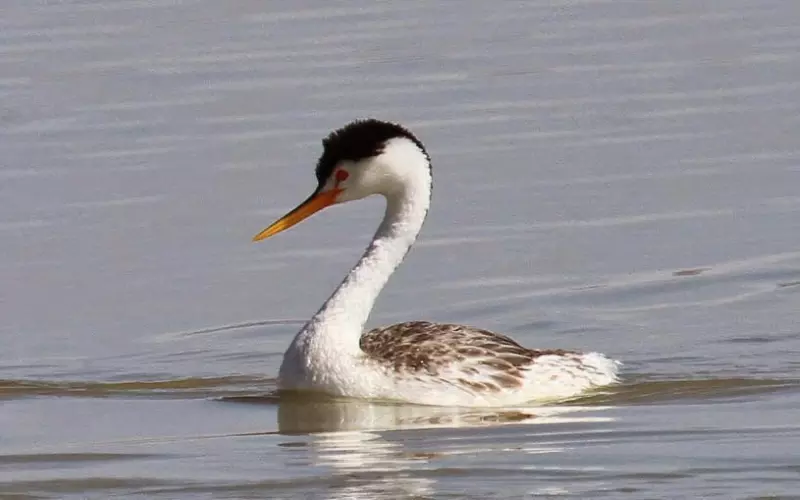
The diet of Clark’s Grebe birds mainly consists of small fish. These birds are excellent divers who swim underwater to catch their prey. They mainly feed on small fish like minnows, which are easy to catch and eat. Sometimes, they eat other aquatic creatures like insects, crustaceans, and tadpoles.
Clark’s Grebe birds have a specific hunting strategy. They often hunt in pairs and can dive up to 20 feet deep to find food. They have long, slender bills that help them catch fish efficiently. These birds swim with grace and agility, using their webbed feet to paddle quickly through the water. When they see a fish, they dive headfirst and swiftly grab it with their sharp beaks.
Clark’s Grebe birds bring fish to the nest to feed their young ones. They regurgitate the food for their chicks, bringing it back up from their stomachs and feeding it to their babies. This is an essential part of their parenting duties, as it helps the chicks grow strong and healthy.
The diet of Clark’s Grebe birds mainly consists of small fish, but they also eat other aquatic creatures. They are skilled divers and use their long beaks to catch their prey underwater. When caring for their young ones, they bring food to the nest and feed them by regurgitation. These birds have fascinating behaviours and characteristics that make them unique and exciting.
Locomotion of Clark’s Grebe
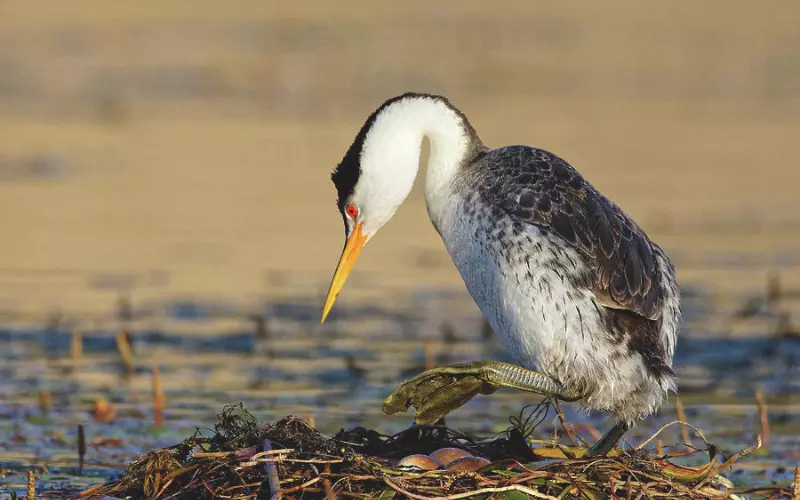
Clark’s Grebe is a bird skilled at moving around in water. It has a unique way of locomotion that helps it glide smoothly across the surface. This bird has long legs and webbed feet, which are fantastic for swimming. When it wants to move, it propels itself forward by paddling its feet quickly. These webbed feet create a lot of power in the water, allowing the bird to reach high speeds. It’s almost like they are running on water!
But the most extraordinary thing about the Clark’s Grebe is its ability to do “rushing.” This is when the bird starts running on the water’s surface, flapping its wings. During this move, they can reach incredible speeds of up to 20 miles per hour! It’s like they are dancing on the water! The grebe uses its wings to steer and balance while running. This locomotion is impressive to watch and very efficient for the bird. It helps them hunt for food and escape from predators. With their unique way of moving, Clark’s Grebes are remarkable birds!
Social and Sexual Behaviour of Clark’s Grebe

Clark’s Grebes are fascinating birds that display unique social and sexual behaviours. These birds can be found in North America and are often seen near lakes and ponds.
Regarding social behaviour, Clark’s Grebes are known for their synchronized dancing rituals. During courtship, these birds engage in a delightful display called the “weed ceremony.” They swim together, making rapid and synchronized movements, carrying pieces of aquatic plants in their beaks. This elaborate dance helps strengthen the bond between mates and is also a way to communicate and establish territory.
In terms of sexual behaviour, Clark’s Grebe’s practice monogamy. They form long-term partnerships and usually mate for life. These birds take turns incubating their eggs and caring for their young, showing high commitment to their families. Additionally, their nests are often built on floating debris or vegetation, providing their offspring with a safe and secure environment.
Clark’s Grebes are remarkable birds with fascinating social and sexual behaviours. Their synchronized dancing rituals and commitment to their mates and offspring demonstrate the importance of strong relationships and family bonds in the animal kingdom. By observing and studying these behaviours, scientists can gain valuable insights into the intricate dynamics of bird species.
Reproduction and Lifecycle of Clark’s Grebe
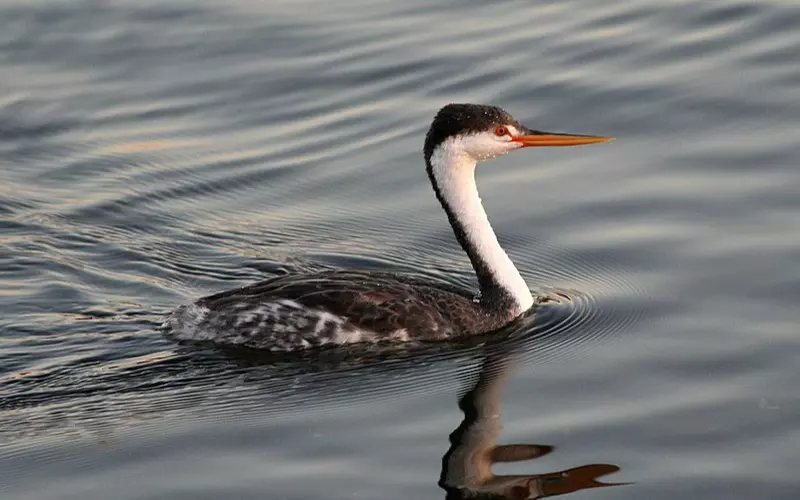
Clark’s Grebes are fascinating birds that have a unique way of reproducing. These birds lay their eggs on floating platforms that they build themselves. The male and female grebes build these structures using aquatic vegetation. Once the platform is sturdy, the female lays one to three eggs. Both parents take turns incubating the eggs and sit on them to keep them warm until they hatch. This is called shared incubation. The eggs take about three weeks to hatch; the parents take turns fishing for food during this time.
Once the eggs hatch, the baby grebes, also known as chicks, are born. At first, the chicks are covered in fluffy down feathers and cannot swim. They rely on their parents for warmth and food. The parents continue to take turns feeding and protecting the chicks. As the chicks grow, they become more independent and start swimming and diving independently. They also develop darker feathers, which help them blend in with the water. The parents teach the chicks to fish and fly, preparing them for adulthood. It takes about two months for the chicks to fully develop and become capable of surviving on their own.
After the chicks have grown and become independent, they leave their parents and start their journey. They find mates and build their floating platforms for nesting. The cycle starts again as these adult grebes lay their eggs, take turns incubating, and raise their chicks. This reproductive and life cycle of Clark’s Grebes is a fascinating process that ensures the survival of these beautiful birds for future generations to enjoy.
Threats to Clark’s Grebe

Threats to Clark’s Grebe bird are looming and must be addressed to ensure their survival and well-being. One major threat comes from habitat loss and degradation. As human populations grow, more and more land is being used for agriculture, urban development, and other human activities. This often leads to the destruction and fragmentation of the grebe’s natural habitats, such as wetlands and lakes. The birds struggle to find suitable nesting and feeding grounds without these habitats, significantly impacting their survival and reproduction ability.
Additionally, pollution poses a significant threat to Clark’s Grebes. Introducing pollutants, such as chemicals and waste, into the water bodies they inhabit can have devastating effects on their health. These pollutants can contaminate their food sources, disrupt their reproductive systems, and weaken their immune systems, making them more susceptible to diseases. Oil spills and toxic chemicals from industries are particularly harmful, as they can cause immediate deaths and long-term harm to the grebes and other wildlife.
Lastly, disturbance caused by human activities is another danger to Clark’s Grebes. Recreational activities such as boating, fishing, and jet skiing can disrupt their natural behaviours, cause stress, and even lead to the abandonment of nests. Noise pollution from human-made structures and vessels further disturbs the birds, making it difficult for them to communicate, find mates, and raise their young. These disturbances can significantly impact their breeding success and overall population numbers.
To ensure the survival of Clark’s Grebes, it is crucial to protect their habitats, minimize pollution, and reduce disturbance from human activities. Preserving and restoring wetlands, lakes, and other crucial habitats is essential. Implementing and enforcing strict regulations on pollutants released into their habitats is also necessary. Lastly, promoting awareness and educating the public about the impact of their actions on these magnificent birds can help reduce disturbances and ensure a healthier environment for Clark’s Grebes and other wildlife to thrive.
Population of Clark’s Grebe
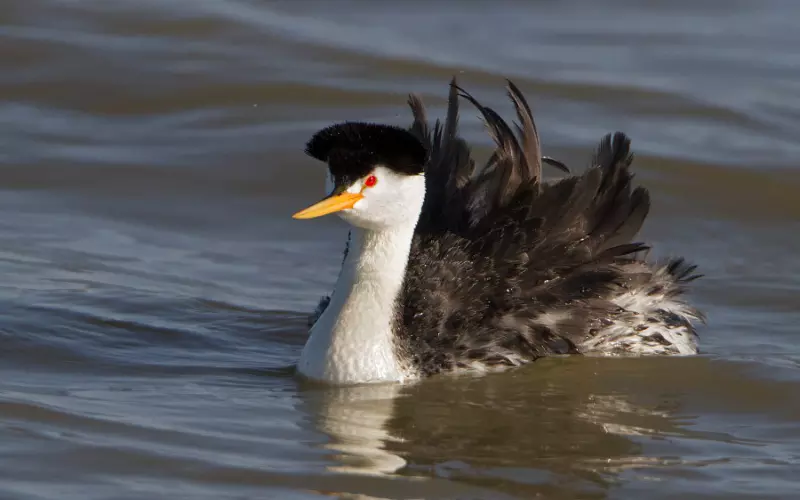
The population of Clark’s Grebe bird, a graceful and beautiful creature, is estimated to be around 25,000 individuals. These birds are commonly found in North America, specifically in the western parts. They make their homes near lakes and rivers, where they build floating nests.
However, Clark’s Grebe bird is not listed as extinct. It is essential to protect their habitats and the environment they thrive in to ensure the survival of these birds. Human activities, pollution, and climate change can significantly impact their population, so we must take measures to safeguard their habitats and preserve their existence.
If Clark’s Grebe bird were to become extinct, it would be a significant loss to the biodiversity of North America. The extinction of any species is a tragedy because it disrupts the delicate balance of nature. We must strive to conserve and protect all species, including the Clark’s Grebe bird, so future generations can appreciate their beauty and contribution to our natural world. Let us work together to ensure their survival and prevent further biodiversity loss.
Conclusion
In this blog post, we have explored the fascinating world of Clark’s Grebe, a beautiful bird that calls North America its home. We have discovered its history, discovered interesting facts about its behaviour, learned about its size and habitat, and explored its classification. Clark’s Grebe is truly an incredible creature that deserves our admiration and protection.
One of the most striking things about Clark’s Grebe is its elegant appearance. Its long neck, slender body, and black and white plumage stand out on the water as it gracefully glides along. Its colourful plumage is not only for aesthetic purposes but also serves as camouflage, helping it blend into its surroundings while hunting for fish.
Another interesting fact about Clark’s Grebe is its unique courtship ritual. During mating season, these birds engage in an elaborate dance where they face each other, quickly move their heads from side to side, and make rhythmic calls. This impressive display not only helps strengthen the bond between the mates but also serves to defend their territory and establish dominance.
Clark’s Grebe is an awe-inspiring bird with a rich history and fascinating characteristics. From its beautiful appearance to its intricate courtship rituals, it captures our attention and leaves us marvelling at the wonders of the animal kingdom. By learning more about these magnificent creatures, we can develop a deeper appreciation for the diversity and beauty of the natural world. Let us strive to protect and preserve these beautiful animals and their habitats for future generations to enjoy.
Frequently Asked Questions about Clark’s Grebe (FAQs)
What is a Clark’s Grebe bird?
Clark’s Grebe (Aechmophorus clarkii) is a waterbird species found in North America.
How can Clark’s Grebe birds be identified?
They are characterized by their long necks, slender bills, and distinctive black and white plumage.
Where are Clark’s Grebe birds commonly found?
These birds are usually found in freshwater lakes, reservoirs, and marshes in the western part of North America.
Do Clark’s Grebe birds migrate?
They do migrate, usually to coastal areas during the winter season.
What do Clark’s Grebe birds eat?
Their diet mainly consists of fish, but they also consume crustaceans and insects.
How do Clark’s Grebe birds catch their prey?
These birds dive underwater to catch their prey using their sharp bills.
Are Clark’s Grebe birds social creatures?
Yes, they are social birds often seen in pairs or small groups.
Can Clark’s Grebe birds fly?
They are skilled at flying and use their wings to travel between breeding and non-breeding grounds.
How do Clark’s Grebe birds communicate with each other?
They use a variety of vocalizations, including calls and displays, to communicate with other members of their species.
Do Clark’s Grebe birds mate for life?
They form long-term pair bonds and generally mate for life.
How do Clark’s Grebe birds build their nests?
They build floating nests of aquatic vegetation, usually in emergent plants or reeds.
When do Clark’s Grebe birds breed?
They breed during the spring and summer months.
How many eggs do Clark’s Grebe birds lay?
They typically lay a clutch of 2-4 eggs.
How long does it take for Clark’s Grebe bird eggs to hatch?
The incubation period lasts approximately 22-27 days.
How long do Clark’s Grebe chicks take to fledge?
It takes around 70-75 days for the chicks to fledge or develop the ability to fly.
Are Clark’s Grebe birds considered threatened or endangered?
While not listed as endangered, conservation efforts are essential to ensure their population remains stable due to habitat degradation and disturbance.

Hey there, I’m Kristen Haudenschild! I’m like a superhero for animals and people.
I work as a Dependable Hard Working Supervisor, which means I help both people and animals grow and learn. I did my school at OdySea Aquarium and Georgia Southern University in Tempe, Arizona. That’s where I learned all about animals, and guess what? I’m fascinated by them!
I even write cool articles about animals. My job history includes being an Animal Trainer and a Marine Mammal Trainer II at OdySea Aquarium. I’ve also been a Senior Animal Care Specialist and an Animal Care Specialist 2.
I love exploring animals and am always ready to help others learn more about them. So, if you ever need info about animals, give me a shout!

